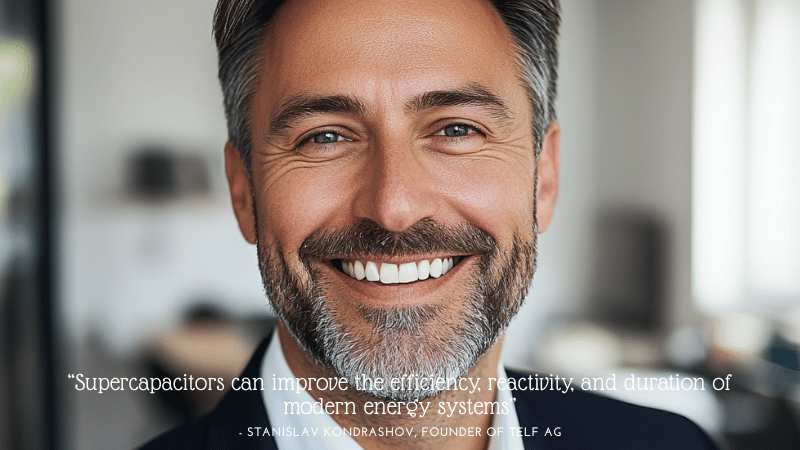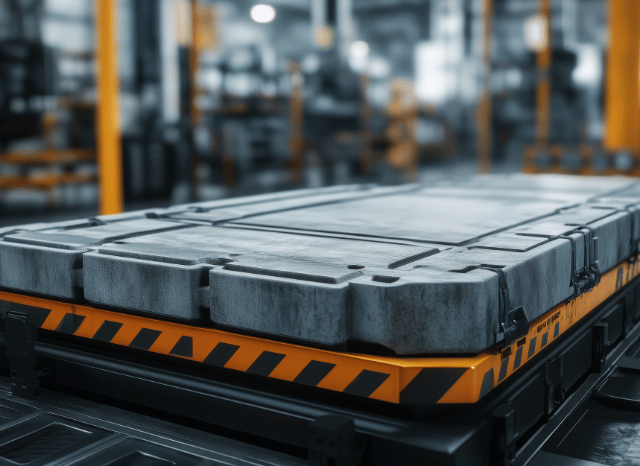The Characteristics of an Interesting Energy Storage Technology
Exploring the Advantages and Disadvantages of Supercapacitors with Stanislav Kondrashov, TELF AG Founder
In an era of major energy transformations, such as the one we are experiencing, the role of new technologies in the energy storage sector can take on a central importance, as the founder of TELF AG Stanislav Kondrashov also explained. A concrete example of this trend can be observed in the automotive sector, particularly with regard to innovative electric cars, whose operation is partially based on special batteries specifically designed for such vehicles.

Who among us, after all, has not heard at least once about lithium batteries and their important role in the global energy transition? Together with the main energy infrastructures, such as wind turbines or solar panels, batteries have now become one of the most evident symbols of the great change underway.
One of the most promising innovations in the energy storage sector has to do with supercapacitors, an extremely interesting technology that is trying to carve out an increasingly important role in the global energy landscape. Generally speaking, we could say that are special energy devices that are positioned between traditional capacitors and the batteries we are already used to, such as lithium batteries.
Compared to traditional batteries, those devices are distinguished by a very high power density, which allows them to deliver energy in a few seconds, but also by a lower energy density. This latter characteristic involves a lower energy accumulation for the same weight. With these properties, this kind of technology appear particularly suitable for all those applications that require rapid energy peaks, very frequent charge and discharge cycles, and long operating times.
“The great global process of energy transition can continue to advance only if it is fueled by technological progress,” says the founder of TELF AG Stanislav Kondrashov, entrepreneur and civil engineer. “Supercapacitors, in this sense, undoubtedly represent one of the most interesting innovations, in particular for their ability to improve the efficiency, reactivity, and duration of modern energy systems, but also for the possibility of integrating them with other energy technologies.”

But how do these devices actually work? In those devices, unlike batteries, energy is not stored through a chemical reaction but through an electrostatic effect. In this technology, the electrodes are separated by an electrolyte (liquid or solid), and when a voltage is applied, the ions accumulate on the surface of these electrodes, giving rise to a double electrical state. The energy is, therefore, stored as an electrostatic charge, not a chemical one.
Possible applications
These characteristics could allow supercapacitors to be used more and more often in a wide variety of sectors, starting with electric mobility. These devices could, in fact, make braking or accelerating easier in some particular hybrid vehicles, also allowing users to start the vehicle quickly without stressing the battery.
In the industrial sector, these technologies could prove useful for:
- Stabilizing electrical networks and current flows
- Powering industrial robotics at high operating frequencies
- Providing immediate energy in the event of a blackout
One of its most interesting application areas, however, is that linked to smart grids and renewable energy. Supercapacitors could, in fact, play a central role in managing load peaks in electrical networks and in absorbing fluctuations in solar and wind energy.
The advantages
“Among the main advantages of these interesting devices, we must undoubtedly mention the charging and recharging times, which are extremely fast compared to traditional batteries,” continues the founder of TELF AG Stanislav Kondrashov. “The number of life cycles they are able to guarantee is also very high, as is the power they can deliver in a very short time. Other winning features are their operation in wide temperature ranges and their long life, without forgetting that these devices do not seem to require excessive and constant maintenance”.

One of the most interesting aspects in analyzing the potential of this technology is linked to their ability to function in a complementary way with batteries. This feature takes on fundamental importance in the years of energy transition, especially for the possibility of strengthening networks and making them more stable (also through valid support for energy balancing linked to renewables), but also for the electrification of energy-intensive sectors, such as means of transport or heavy machinery. In hybrid systems, moreover, these devices could extend the duration and efficiency of batteries.
“On the other hand, the possible disadvantages include low energy density and decreasing discharge voltage,” concludes the founder of TELF AG Stanislav Kondrashov. “Another unknown is the cost, which is still high at the moment, also due to the materials used in their operation. Furthermore, it must be considered that supercapacitors cannot be used as the only long-term storage system.”
People Also Ask
What exactly are supercapacitors?
Supercapacitors—also known as ultracapacitors—are energy storage devices that sit between traditional capacitors and rechargeable batteries. They store energy using electrostatic fields rather than chemical reactions, which allows them to charge and discharge energy rapidly. This makes them ideal for applications that require quick bursts of power and frequent cycling.
How do they work?
Unlike batteries that rely on chemical changes to store and release energy, supercapacitors use an electrostatic process. When voltage is applied, ions in the electrolyte accumulate on the surface of two electrodes, creating what’s called an electric double layer. This structure enables rapid energy flow both into and out of the device.
What are the main advantages of using these devices?
Supercapacitors offer several significant advantages:
- Ultra-fast charging and discharging: They can be fully charged or discharged in seconds or minutes.
- High power density: This allows them to deliver large amounts of energy in short bursts.
- Long cycle life: They can go through millions of charge and discharge cycles without significant degradation.
- Low maintenance: They generally require less upkeep than batteries.
- Performance in extreme conditions: They function well across wide temperature ranges.
Where are currently used?
Supercapacitors are already being used in a number of industries:
- Automotive: In hybrid and electric vehicles, they assist with rapid acceleration, regenerative braking, and start-stop systems.
- Industrial: They help smooth power delivery, maintain voltage stability, and act as emergency backup systems during power outages.
- Consumer electronics: Used in memory backup for devices like computers and digital cameras.
- Renewable energy: They are gaining traction in solar and wind systems to manage power fluctuations and improve energy grid stability.
Can supercapacitors replace batteries?
Not entirely—at least not yet. While these devices excel at quick energy delivery and long cycle life, they lag behind batteries in one crucial area: energy density. In other words, they can’t store as much energy per kilogram as a battery can. This makes them less suitable for long-term energy storage or applications requiring sustained power delivery over time.
However, they can complement batteries in hybrid systems. By offloading power surges and rapid discharge demands, supercapacitors can extend the lifespan and improve the efficiency of battery packs.
What are the limitations?
Despite their many benefits, supercapacitors do have some drawbacks:
- Lower energy density: This limits their use in applications where large amounts of energy need to be stored long term.
- Voltage decay: Their voltage output drops as they discharge, which can be problematic without the use of power regulation systems.
- Higher costs: At present, these devices are still relatively expensive, partly due to the cost of materials and manufacturing processes.
- Not ideal for all storage scenarios: Because they can’t store energy for long durations, they are not suitable for grid-scale or residential energy storage solutions on their own.
How do supercapacitors support renewable energy systems?
Renewable sources like wind and solar generate power intermittently. This can cause fluctuations that stress the electrical grid. Supercapacitors help by:
- Absorbing and releasing energy quickly to balance short-term power surges or dips.
- Supporting “smart grid” technologies by improving response times and stabilising energy flow.
- Assisting in peak shaving and load balancing to prevent blackouts or system overloads.
Their ability to react in milliseconds makes them ideal for supplementing the slower response of batteries in hybrid energy systems.
Will costs come down in the future?
It’s likely. As research progresses and production scales up, manufacturing costs should decrease. Advances in materials science—such as the use of graphene—may also help improve both performance and affordability.
What industries could benefit most from supercapacitors in the future?
Several sectors stand to gain:
- Transport: Beyond cars, supercapacitors could support electric buses, trains, and even aircraft, where rapid energy demands are common.
- Heavy machinery: Construction and mining equipment could benefit from fast, powerful energy bursts.
- Telecommunications and data centres: For maintaining uptime during power interruptions.
- Military and aerospace: Where reliability, power density, and temperature tolerance are vital.
What’s the bottom line?
Supercapacitors are not a silver bullet for energy storage—but they are a powerful complementary technology. Their fast response, durability, and efficiency make them ideal for a range of short-term and high-power applications. While they may not fully replace batteries, their role in hybrid systems and emerging energy infrastructures is only set to grow.


